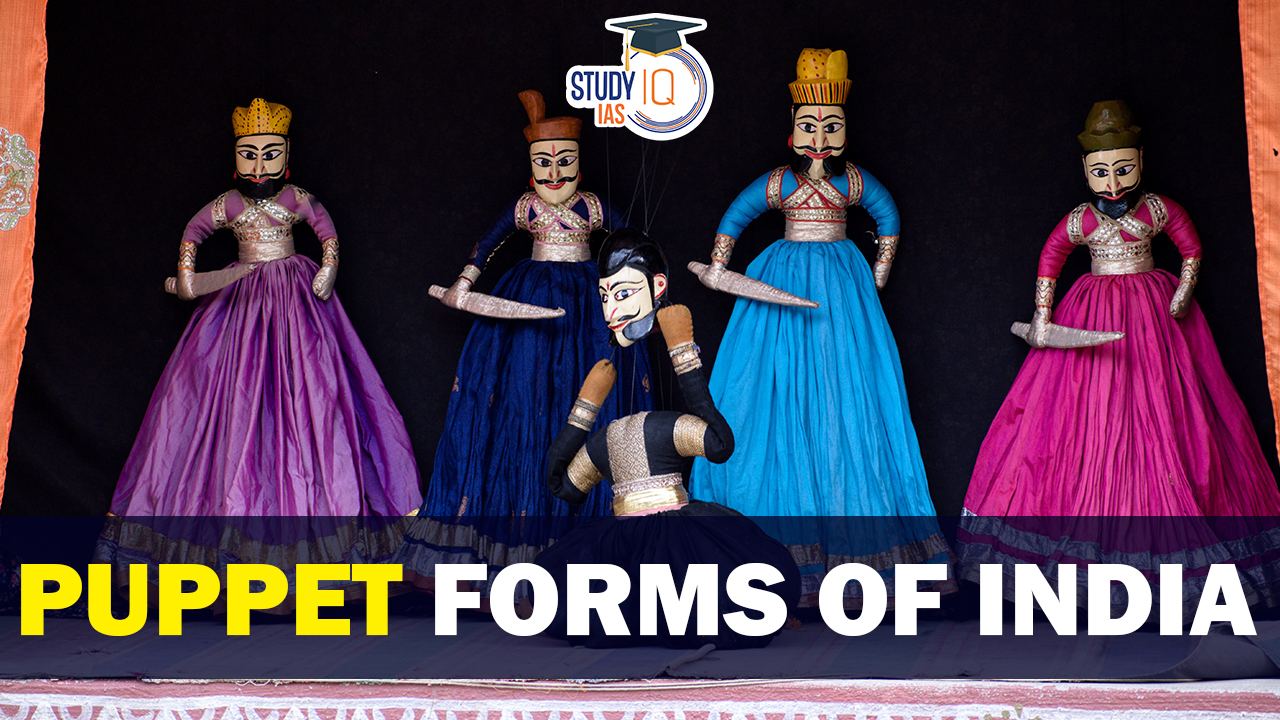Table of Contents
Puppetry is a form of theater that involves manipulating puppets, which are inanimate objects that resemble human or animal figures. Puppetry is believed to have originated in India more than 500 years before Christ. Puppetry has been an important part of traditional entertainment in India. The plots of puppet shows are often inspired by religious texts such as the Mahabharata, Ramayana, and the Puranic texts.
We’re now on WhatsApp. Click to Join
Origin of Indian Puppetry
Puppetry in ancient India dates back to the Harappa and Mohenjo-Daro civilizations, evident from socketed puppet discoveries. By 500 BC, marionette theatre allusions emerged, and references in the Tamil classic Silappadikaram and the Mahabharata showcased its early significance. In Indian philosophy, the Bhagavad Geeta symbolizes God as a puppeteer, managing the cosmos with three strings. Indian theatre designates the storyteller as the Sutradhar or “string bearer.” Diverse puppetry traditions, drawing inspiration from mythology and local tales, flourished across India, blending painting, sculpture, music, dance, and drama. Sadly, contemporary challenges, such as a diminishing audience and financial instability, threaten the continuity of this unique artistic form.
Puppet Forms of India
India is home to a vibrant array of puppetry forms, each deeply rooted in regional cultures, traditions, and artistic expressions. These puppet forms have been passed down through generations, evolving over time and adapting to the changing socio-cultural landscape. Here is a detailed exploration of some prominent puppet forms in India:
Kathputli (String Puppets)
- Origin: Rajasthan
- Materials: Wooden puppets with intricate detailing, adorned in traditional attire.
- Performance: Kathputli involves string manipulation to bring the puppets to life. Stories often revolve around historical events, local legends, and tales from epics like the Ramayana and Mahabharata.
Tholu Bommalata (Shadow Puppets)
- Origin: Andhra Pradesh
- Materials: Leather puppets with detailed cut-outs.
- Performance: Tholu Bommalata is characterized by the use of intricate leather puppets that cast shadows on a screen. The narratives are drawn from Hindu mythology and local folklore.
Gombeyatta (Rod Puppets)
- Origin: Karnataka
- Materials: Wooden puppets with articulated limbs controlled by rods.
- Performance: Gombeyatta puppetry involves dynamic movements with the help of rods, depicting stories rooted in local traditions and folklore.
Pavakoothu (Glove Puppets)
- Origin: Kerala
- Materials: Wooden glove puppets covered in cloth.
- Performance: Puppeteers wear these puppets on their hands, presenting stories from the Ramayana, Mahabharata, and other mythological narratives. Pavakoothu often includes vibrant music and dance.
Yampuri
- Origin: Himachal Pradesh
- Materials: Wooden puppets with string manipulation.
- Performance: Yampuri puppetry highlights the local customs and traditions of Himachal Pradesh. Puppets are manipulated with strings to enact stories and entertain audiences.
Sutradhar (String Bearer)
- Context: While not a specific puppet form, the Sutradhar or string bearer is an important element in Indian classical theater. The term symbolizes the storyteller or narrator in Sanskrit drama, often drawing parallels with the puppeteer guiding the puppets.
Bommalattam (String Marionettes)
- Origin: Tamil Nadu
- Materials: String marionettes made from wood and cloth.
- Performance: Bommalattam combines intricate string manipulation with colorful puppetry, presenting stories from mythology and cultural themes.
Putul Nach (Doll Dance)
- Origin: West Bengal
- Materials: Wooden, cloth, and clay dolls.
- Performance: Putul Nach involves the art of dancing dolls, each representing a character. Performances often address social issues and convey narratives through dance and music.
Kondapalli Bommalu
- Origin: Andhra Pradesh
- Materials: Lightweight wooden puppets with vibrant colors.
- Performance: Kondapalli Bommalu showcases brightly colored puppets depicting mythological characters and stories. The performances are known for their lively and engaging nature.
Koothu and Bommalattam (Glove Puppets)
- Region: Tamil Nadu
- Materials: Combination of glove puppets and rod puppets.
- Performance: Koothu and Bommalattam combine different puppetry elements to present stories from epics and local folklore, often accompanied by music and dance.
Current Status of Indian Puppetry
Challenges
- Diminishing Audience: Traditional puppetry faces challenges in attracting modern audiences, especially younger generations who may be more inclined towards digital entertainment.
- Financial Instability: Many puppeteers struggle with financial stability, as puppetry is often not as economically lucrative as other forms of entertainment.
- Lack of Infrastructure: Some regions lack proper infrastructure and support for puppeteers, impacting the growth and sustainability of the art form.
Initiatives and Revival Efforts
- Cultural Festivals: Various cultural festivals in India include puppetry as a part of their programs, providing a platform for puppeteers to showcase their talent and reach a wider audience.
- Educational Programs: Some organizations and individuals are working to integrate puppetry into educational programs, both formal and informal, to raise awareness and appreciation for this traditional art form.
- Government Support: In certain instances, there have been initiatives by governmental bodies to provide financial support and recognition to puppeteers and puppetry groups.
Innovation and Fusion
- Contemporary Themes: Puppeteers are exploring ways to incorporate contemporary themes and issues into their performances to make them more relevant to modern audiences.
- Collaborations: Collaborations with other art forms, such as music, dance, and theater, are being explored to create more engaging and multidimensional puppetry performances.
International Exposure
- Global Platforms: Some Indian puppeteers have gained recognition on international platforms, contributing to a broader appreciation of Indian puppetry worldwide.
Digital Platforms
- Online Presence: With the advent of digital platforms, some puppeteers are exploring online spaces to showcase their performances and reach a wider audience.
Puppet Forms of India UPSC
Indian puppetry, originating over 500 years before Christ, is deeply rooted in cultural traditions. Ancient references in Harappa and Mohenjo-Daro showcase its historical significance. Diverse forms like Kathputli, Tholu Bommalata, and Gombeyatta emerged, drawing inspiration from epics and local tales. Puppetry is mentioned in philosophical texts, with the Bhagavad Geeta symbolizing God as a puppeteer. Presently, challenges include a declining audience and financial instability. Initiatives involve cultural festivals, educational programs, and government support. Puppeteers innovate by incorporating contemporary themes and collaborating with other art forms. International exposure and digital platforms contribute to preserving and promoting this unique Indian artistic heritage.


 Poompuhar Port: Ancient Sangam-Era Marit...
Poompuhar Port: Ancient Sangam-Era Marit...
 UNESCO World Heritage Sites of India Lis...
UNESCO World Heritage Sites of India Lis...
 Moran Community of Assam, History, Langu...
Moran Community of Assam, History, Langu...

























